
Optimizing Separation: A Comprehensive Exploration of Polyhedral Hollow Balls
Polyhedral hollow balls, which are often referred to as polyhedral ball packing, are a sort of structured packing that is used in a variety of separation processes, such as distillation, absorption, and stripping. Specifically, they are intended to improve separation performance while also facilitating effective mass transfer.
Plastic polymers such as polypropylene (PP), polyethylene (PE), or polyvinyl chloride (PVC) are frequently used in the production of polyhedral hollow balls. They have a one-of-a-kind geometric form that is reminiscent of a polyhedron, with numerous faces that are either flat or curved and interiors that are hollow. In order to generate a packed bed that has a wide surface area for gas-liquid interaction, these balls are piled inside a column or vessel.
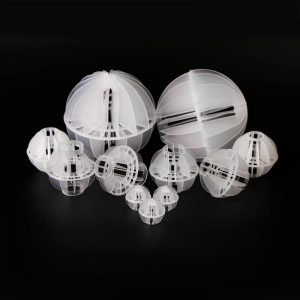
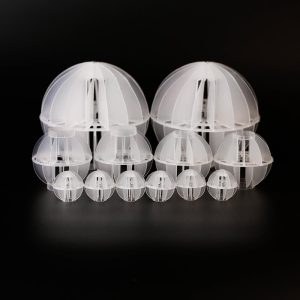
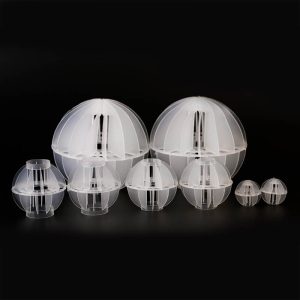
| Size
mm |
Surface Area
㎡/m³ |
Void fraction
% |
Bunk number
Pieces/m3 |
| Φ25 | 460 | 90 | 64000 |
| Φ38 | 325 | 91 | 25000 |
| Φ50 | 237 | 91 | 11500 |
| Φ76 | 214 | 92 | 3000 |
| Φ100 | 193 | 80 | 2800 |
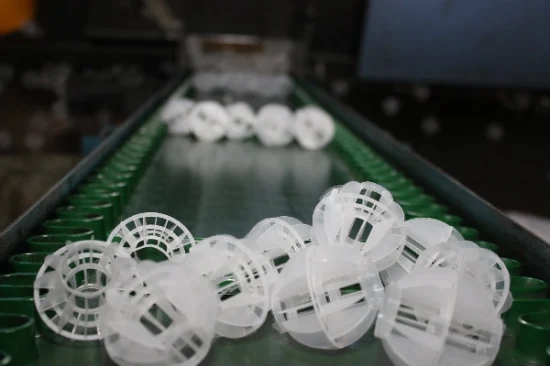
1. Surface Area: Because of its geometric structure and hollow innards, polyhedral hollow balls provide a huge surface area per unit volume (also known as the surface area per unit volume). Through the promotion of effective mass transfer between the gas and liquid phases, this increased surface area contributes to an improvement in separation efficiency.
2. Low-Pressure Drop: Polyhedral hollow balls often have a low-pressure drop, which indicates that they provide a little amount of resistance to the flow of fluid. This quality contributes to a reduction in both the amount of energy used and the expenses of operation.
3. High Capacity: The one-of-a-kind construction of polyhedral hollow balls makes it possible for them to have a high capacity for the handling of liquids and gases. High flow rates may be accommodated by them, and they are suited for applications that have throughput requirements that are very demanding.
4. Uniform Gas and Liquid Distribution: The polyhedral hollow balls’ geometric design encourages uniform gas and liquid distribution throughout the packed bed. This is also referred to as the “fourth principle.” This guarantees that the two phases are effectively in touch with one another, which improves the separation performance.
5. Chemical Resistance: Polyhedral hollow balls made of plastic materials such as polypropylene (PP), polyethylene (PE), or polyvinyl chloride (PVC) provide high chemical resistance. They are able to tolerate a large variety of corrosive chemicals that you may come across throughout the separation process.
6. Ease of Installation: Polyhedral hollow balls are simple to install and need little maintenance, which brings us to our sixth point: ease of installation. They are able to be retrofitted into vessels or columns that already exist without requiring considerable alterations.
When high separation efficiency, low pressure drop, and chemical resistance are critical requirements in an application, polyhedral hollow balls are often utilised as a solution. The chemical processing industry, the petrochemical industry, the oil and gas refining industry, and environmental engineering are all examples of industries that make use of them.
It is important to note that the precise selection of packing material, which may include polyhedral hollow balls, should be based on the specific separation needs, the circumstances of the process, and the compatibility with the fluids used in the process.


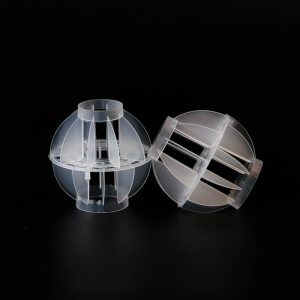
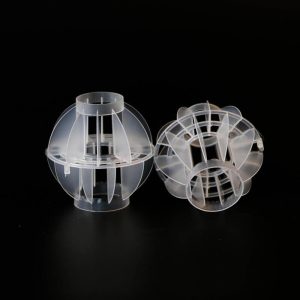
1. Distillation:During the distillation process, polyhedral hollow balls are often used in distillation columns. This allows for the separation of liquid mixtures according to the boiling points of the individual components. They have a high surface area that allows for effective interaction between the liquid and vapour phases, which in turn promotes the separation of components that have varying levels of volatility. The polyhedral shape of the balls guarantees that the gas and liquid are distributed uniformly, which greatly improves the efficiency of the separation process.
2. Absorption: Polyhedral hollow balls are used in absorption columns for the purpose of removing gaseous contaminants or recovering valuable components from gas streams. This process is known as absorption. They make it possible for the gas phase and the liquid phase to come into close contact with one another, which in turn makes it possible for solutes to move from the gas phase into the liquid phase. The polyhedral form, which provides a high surface area, contributes to an increase in the efficiency of the absorption process.
3. Stripping: Polyhedral hollow balls are used in the process of stripping, which is the act of removing volatile components from anything that is liquid. Within the context of this application, the balls provide a substantial surface area that supports the process of evaporating the volatile components from the liquid phase. The polyhedral form facilitates the efficient movement of heat and mass, which in turn enables stripping operations to be carried out effectively.
4. Treatment of Wastewater Polyhedral hollow balls are used in wastewater treatment systems, such as air stripping towers and biological treatment units, both of which are examples of such systems. In biological treatment operations, they either offer a medium for the attachment of microorganisms or help remove volatile pollutants from the liquid phase. Both of these purposes are accomplished with their assistance. A excellent gas-liquid contact is ensured by the polyhedral shape, which also contributes to an improvement in the performance of the treatment system.
Polyhedral hollow balls provide a number of benefits, including a large surface area, a low pressure drop, uniform distribution, and resistance to chemical substances. Because of these characteristics, they are suited for a broad variety of separation applications in a variety of sectors, including environmental engineering, petrochemicals, refineries, and chemical processing.
When choosing polyhedral hollow balls or any other kind of packing material for a given application, it is essential to take into account the unique separation requirements, operating circumstances, and compatibility with process fluids.
1. Polypropylene (PP): Polypropylene is a material that is often used for polyhedral hollow balls because of its high level of chemical resistance, cheap cost, and widespread availability. Because polypropylene (PP) is resistant to a wide variety of acids, alkalis, and organic solvents, it may be used in a wide variety of applications within the chemical industry.
2.Polyethylene (PE):In addition to polyethylene (PE), polyethylene is another material that is often used for polyhedral hollow balls. The chemical resistance, durability, and low friction features of this material are all quite admirable. Polyethylene (PE) is a material that is often used in applications that need resistance to wear, impact, and abrasion.
3. Polyvinyl Chloride (PVC): PVC is a versatile material that is utilised for a variety of reasons in the industrial sector, including the production of polyhedral hollow balls. When it comes to chemical resistance, mechanical strength, and durability, PVC is an excellent material. It is used often in a variety of sectors, including chemical processing, water treatment, and others.
4. Polyvinylidene Fluoride (PVDF): PVDF is a high-performance polymer that is well-known for its exceptional resistance to chemical substances, resilience to high temperatures, and resistance to ultraviolet (UV) radiation. Polyhedral hollow balls made of polyvinylidene fluoride (PVDF) are appropriate for use in applications that include high-temperature conditions or hostile chemicals.
5. Other Materials: The production of polyhedral hollow balls may also include the utilisation of other materials, such as polyethylene terephthalate (PET), polytetrafluoroethylene (PTFE), and specialised technical plastics. This is contingent upon the particular criteria that are being met.
The selection of the material is determined by a number of criteria, including the chemical compatibility of the material with the process fluids, the conditions of temperature and pressure, the mechanical qualities, and certain considerations on cost. Therefore, it is essential to choose a material that is capable of withstanding the particular working circumstances and providing the appropriate performance characteristics for the application that is being considered.